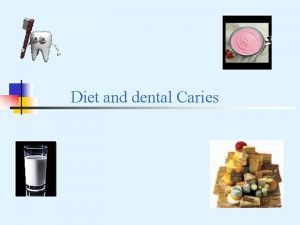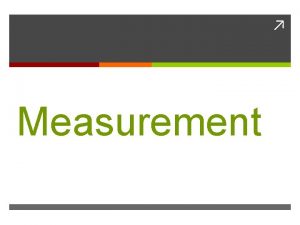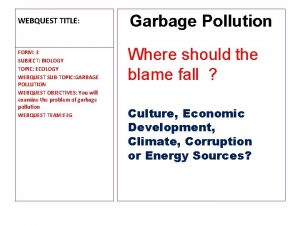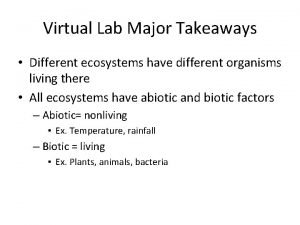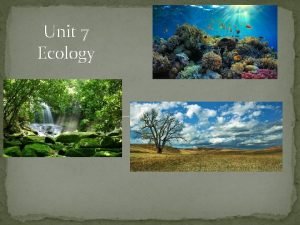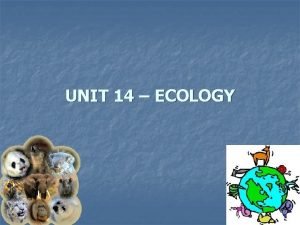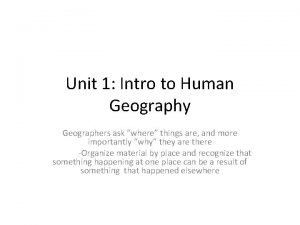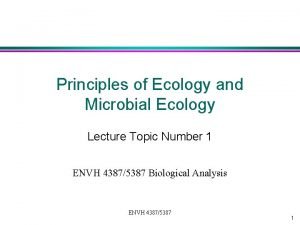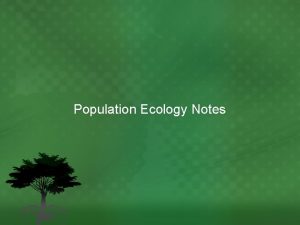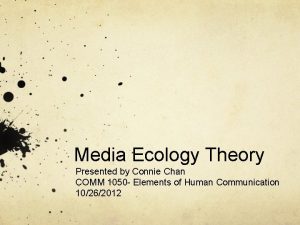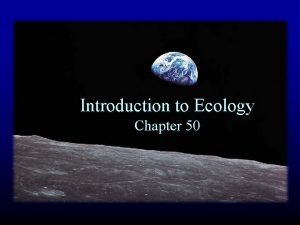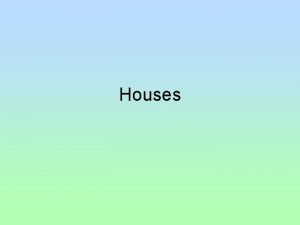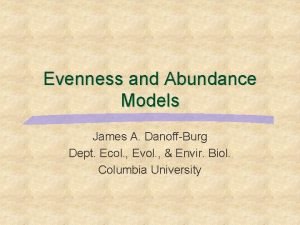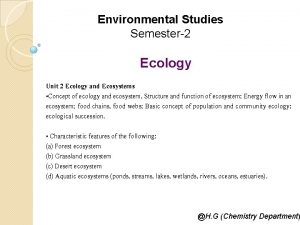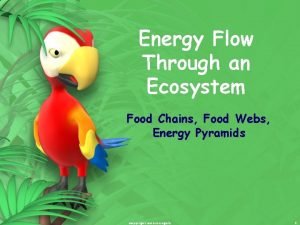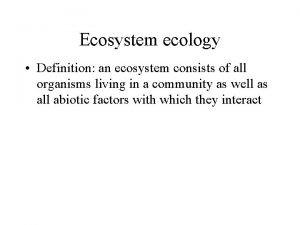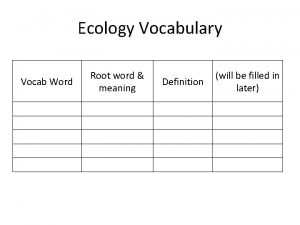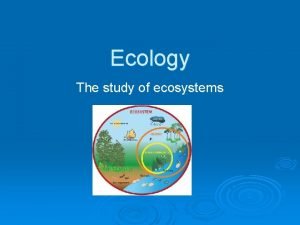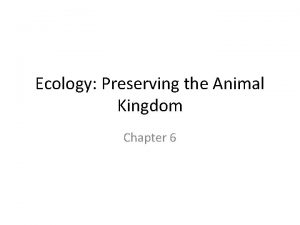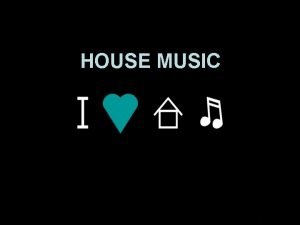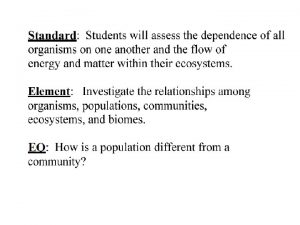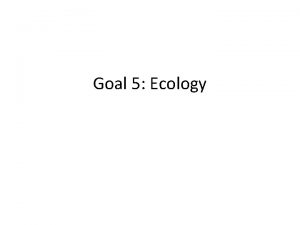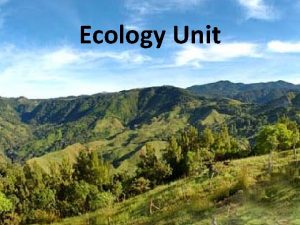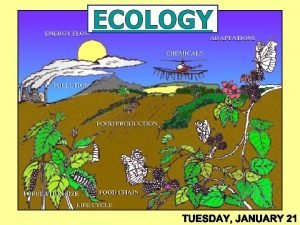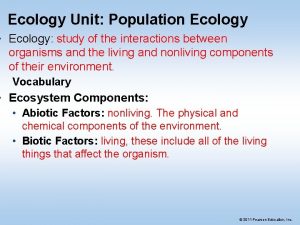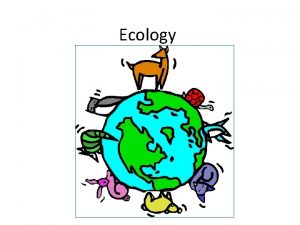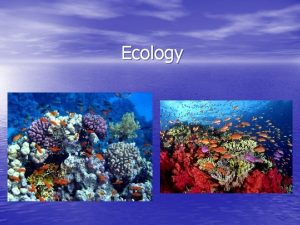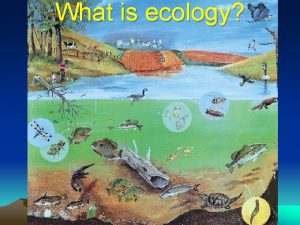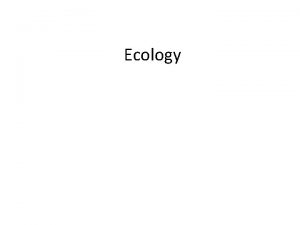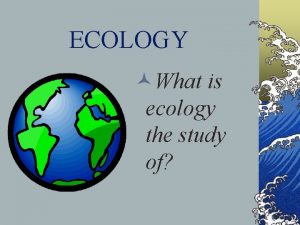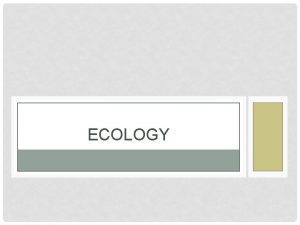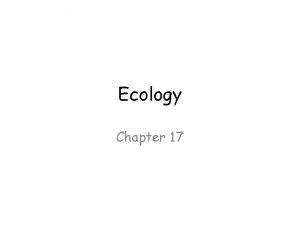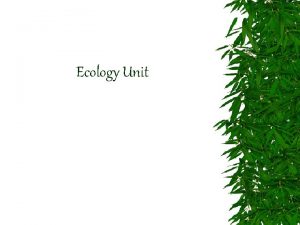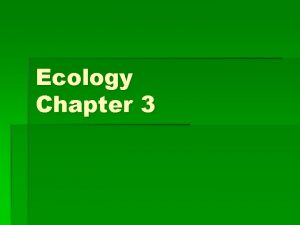Ecology Means house Means study of Study of













































- Slides: 45

Ecology Means “house” Means “study of” “Study of (natures) house” The scientific study of interactions that take place between organisms and their environment. © J Beauchemin 2006

Levels of Organization

What are the Simplest Levels? • Atom • Molecule • Cell • Tissue • Organ System • Organism

Levels of Organization • Ecologists have organized the interactions an organism takes part in into different levels according to complexity.

1 st Level of Organization • Organism a. k. a. species : An individual living that is made of cells, uses energy, reproduces, responds, grows, and develops A single zebra

2 nd Level of Organization • Population: A group of organisms, all of the same species, which interbreed and live in the same place at the A group of same time. zebras

3 rd Level of Organization • Community: All the populations of different species that live in the same place at the same time. All the zebras & wildebeest

4 th Level of Organization • Ecosystem: Populations of plants and animals that interact with each other in a given area along with the abiotic components of that area. – BIOME: A group of ecosystems with the same climate & dominant communities All the animals plus the nonliving components (i. e. rocks, weather, water etc. )

th 5 Level of Organization • Biosphere: The portion of Earth that supports life. – Life is found in air, on land, and in fresh and salt water.

What level of organization? Organism

What level of Organization? Community

What level of Organization? Population

ECOSYSTEM BASICS: ECOSYSTEMS Interactions between the biotic and abiotic components of an environment

The Living Environment • BIOTIC THE LIVING PARTS of an organisms environment. • All organisms depend on others directly or indirectly for food, shelter, reproduction, or protection.

The Nonliving Environment • ABIOTIC THE NON-LIVING PARTS of an organism’s environment. – Examples include air currents, temperature, moisture, light, and soil. • Abiotic factors affect an organism’s life.

Abiotic or Biotic? Biotic

Abiotic or Biotic? Abiotic

Abiotic or Biotic? Abiotic

Habitat & Niche • HABITAT: is the place a plant or animal lives – EX: a birds habitat is its nest, essentially, its “address” – Includes biotic & abiotic factors • NICHE : is an organism’s TOTAL way of life; its “occupation” – Includes its place in a food web – The range of temperature it needs to survive – The type of food it eats – When and how it reproduces

ESSENTIAL VOCABULARY! Here are some important terms that will help you describe interactions in a food chain & web.

Eat or be eaten PRODUCER a. k. a. (Autotroph) Auto= self Troph= nutrition – Organism that can “self” feed, i. e. make its own food – Use photosynthesis or chemosynthesis to produce glucose

Mmmmm…delicious. CONSUMER a. k. a (heterotroph) Hetero= other/different Troph= nutrition - Organism that must consume “others” because it can not make its own food There are several words that describe consumers… – Prey: the hunted – Predator: the hunter – Herbivore: eats plants – Carnivore: eats animals – Omnivore: eats both plants and animals

Hey, you gonna eat that? DECOMPOSER: – Breaks down dead organisms – Examples: bacteria, maggots, fungi, worms – Complete the circle of life by returning nutrients to the soil

Jus gimmie the left overs! • SCAVENGER: an organism who feeds on refuse (trash) or carrion (dead, decaying matter) • Play an important role in the ecosystem by contributing to the decomposition of dead animal remains. Vulture Dung beetle


FOOD CHAIN Definition- Traces the path of nutrients and energy from producer to top consumer v. Show’s “who eats who” v. Arrows indicate the flow of energy “FROM” what is consumed “TO” the consumer Producer Primary Consumer Secondary Consumer

Food webs Definition- show more complex feeding interactions between organisms • Food webs show “what eats what” • Several “food chains” interacting with each other

FOOD CHAIN & TROPHIC LEVELS v. A TROPHIC LEVEL is the position occupied by an organism in a food chain. v. Trophic levels can be analyzed on an energy pyramid.

LEAST ENERGY HERE RULE OF TEN: ONLY 10% OF PREVIOUS ENERGY IS AVAILABLE FROM ONE LEVEL TO THE NEXT 90% LOST AS HEAT! MOST ENERGY HERE

Energy in Ecosystems • Every level you go up, you divide the amount of energy by “ 10” RULE OF TEN: ONLY 10% OF PREVIOUS ENERGY IS AVAILABLE FROM ONE LEVEL TO THE NEXT 90% LOST AS HEAT!

Rule of 10 Every level you go up you divide the amount of energy by 10 0. 2 Joules 200 Joules

0. 2 Joules 200 Joules

Ecological Pyramids Pyramid of Numbers SHOWS THE NUMBER OF INDIVIDUALS AT EACH TROPHIC LEVEL Energy Pyramid SHOWS THE AMOUNT OF ENERGY AVAILABLE AT EACH TROPHIC LEVEL. Organisms use about 10% of this energy for life processes. The rest is lost as heat. Biomass Pyramid SHOW THE AMOUNT OF “LIVING” MATTER AT EACH TROPHIC LEVEL. The MOST biomass is at the bottom of the pyramid

Biomass Pyramids • Bio=life Mass=how much matter • Bio + Mass = how much of living matter within an ecosystem. • Energy is sometimes considered in terms of biomass, the mass of all the organisms and organic material in an area. • MORE biomass at trophic level of PRODUCERS (There are more plants on Earth than there animals. ) • LESS biomass at trophic level of CONSUMERS

LEAST BIOMASS MOST BIOMASS

Biomass • Biomass does NOT always follow the rule of 10. • Instead the boxes are drawn bigger to show bigger amounts and smaller to show smaller amounts.

Biomass Analysis Question • What happens with the phytoplankton that lets it have the most energy but the smallest biomass? ANSWER: It makes new phytoplankton very quickly, so even though it gets eaten quickly it also regenerates quickly

Pyramid of Numbers • Pyramids of Numbers tell you how many of each organism there are QUESTION: Will there always be more producers than consumers?

Pyramid of Numbers • Pyramids of Numbers tell you how many of each organism there are Will there always be more producers than consumers? No! Here there are only 200 trees but 150, 000 insects can live in those trees!

Biological Magnification • toxins in any trophic level effects the other levels. Most toxin The tiny primary consumers eat a little bit of the toxin. The secondary consumers eat many of the 1 st consumers so they eat more of the toxin Least toxin The tertiary consumers eat many of the 2 nd consumers so they eat even more of the toxin At every level the amount of toxin increases! What would a pyramid for this look like?

PUT IT ALL TOGETHER LET’S REVIEW

v. ORGANISMS THAT CAN MAKE THEIR OWN FOOD v. At the base of EVERY food chain/web v. MOST energy v. MOST biomass Producers (AUTOTROPH) 1000 J

v. ORGANISM THAT FEEDS OF OTHER ORGANISMS BECAUSE THEY CANT MAKE THEIR OWN FOOD v. HERBIVORE= “Plant Eater” Primary consumer (HERBIVORE) 100 J

v. ORGANISM THAT FEEDS OF OTHER ORGANISMS BECAUSE THEY CANT MAKE THEIR OWN FOOD Secondary Consumer (CARNIVORE OR OMNIVORE) 10 J v. LEAST ENERGY v. LEAST BIOMASS v. CARNIVORE= “Meat Eater” v. OMNIVORE= “Plant & Meat Eater”

Secondary Consumer 10 J Primary consumer 100 J Producers 1000 J
 Ecology study guide
Ecology study guide Chapter 3 section 1: community ecology answer key
Chapter 3 section 1: community ecology answer key Ecology is the study that helps to preserve
Ecology is the study that helps to preserve What is acceptance house
What is acceptance house Snug bugs home
Snug bugs home Banished boarding house
Banished boarding house My house shall be called a house of prayer
My house shall be called a house of prayer They went house to house
They went house to house Gad4d
Gad4d Hopewood house study
Hopewood house study Vipeholm study conclusions
Vipeholm study conclusions Binh house
Binh house Triangle quadrilateral pentagon hexagon octagon
Triangle quadrilateral pentagon hexagon octagon Meta means and morphe means
Meta means and morphe means Meta means change and morph means heat
Meta means change and morph means heat In situ conservation
In situ conservation Life bio
Life bio Ecology webquest answers
Ecology webquest answers Communities and biomes virtual lab answers
Communities and biomes virtual lab answers Unit 7 ecology answer key
Unit 7 ecology answer key Biotic community is another name for____
Biotic community is another name for____ Cultural ecology ap human geography
Cultural ecology ap human geography The geometric arrangement of objects in space
The geometric arrangement of objects in space Chapter 1 science and the environment
Chapter 1 science and the environment Whats climax community
Whats climax community Ecology deals with
Ecology deals with Whats a niche
Whats a niche Clumped dispersion
Clumped dispersion Biotic potential in ecology
Biotic potential in ecology Exponential growth formula ecology
Exponential growth formula ecology Ecology of media and information literacy
Ecology of media and information literacy What is media ecology
What is media ecology Organismal ecology
Organismal ecology Chapter 52: an introduction to ecology and the biosphere
Chapter 52: an introduction to ecology and the biosphere Folk housing
Folk housing Ecology
Ecology Organismal ecology
Organismal ecology Broken stick model ecology
Broken stick model ecology Difference between ecosystem and ecology
Difference between ecosystem and ecology Food chain in garden ecosystem
Food chain in garden ecosystem An ecosystem consists of
An ecosystem consists of Ecology vocab
Ecology vocab Ecology definition
Ecology definition Levels of organization in ecology
Levels of organization in ecology Honors biology ecology test
Honors biology ecology test Ecology preserving the animal kingdom
Ecology preserving the animal kingdom










